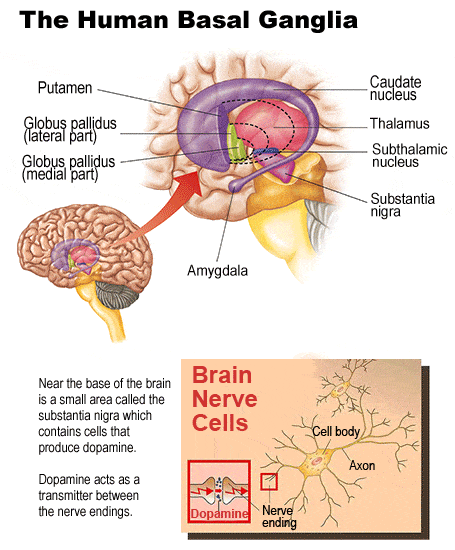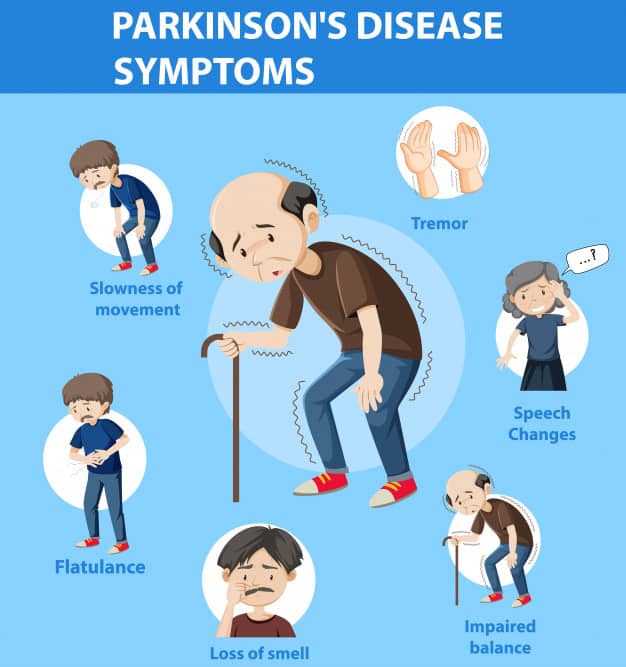Why Do Parkinsons Patients Lose Weight
Several causes may induce weight loss. Weight loss is a non-specific symptom and could be a sign of a wide variety of medical problems, including cancer. Therefore, acute weight loss is an entity that a physician should examine to identify its cause.
Suppose the patient suffers from Parkinsons disease, and the physician does not find any other possible cause. In that case, the weight loss shall be attributed to Parkinsons.
Among PD patients, many possible causes may lead to weight loss. The reasons vary from people to people, but each one can contribute to developing weight loss. People with Parkinsons disease have a decrease in appetite, and it has various possible causes.
- The alteration, in the sense of smell, disables them from tasting food and reducing the amount of food.
- Apathy and depression
- Nausea due to medications
Asides from the appetite loss, other possible causes go along with the motor symptoms of the disease. These motor symptoms may induce an increase in energy expenditure.
- Dyskinesias are pointless and involuntary movements that can be a side effect of the treatment with levodopa.
- Essential tremor, resting tremor, and as well as muscle stiffness can be causes of excessive energy consumption and subsequent weight loss.
When Should I See My Healthcare Provider Or When Should I Seek Care
You should see your healthcare provider as recommended, or if you notice changes in your symptoms or the effectiveness of your medication. Adjustments to medications and dosages can make a huge difference in how Parkinsons affects your life.
When should I go to ER?
Your healthcare provider can give you guidance and information on signs or symptoms that mean you should go to the hospital or seek medical care. In general, you should seek care if you fall, especially when you lose consciousness or might have an injury to your head, neck, chest, back or abdomen.
Related Diagnosis: Lewy Body Dementia
Current research is helping to differentiate dementia related conditions in relationship to Parkinsonâs disease. Doctorâs use a 12-month arbitrary rule to aid in diagnosis. When dementia is present before or within 1 year of Parkinsonâs motor symptoms developing, an individual is diagnosed with DLB. Those who have an existing diagnosis of Parkinsonâs for more than a year, and later develop dementia, are diagnosed with PDD.
In the simplest terms, Lewy bodies are abnormal clumps of proteins that develop in nerve cells. Cholinesterase inhibitors, medications originally developed for Alzheimerâs disease, are the standard treatment today for cognitive DLB and PDD symptoms. Early diagnosis is important, as DLB patients may respond differently than Alzheimerâs disease patients to certain drug, behavioral, and dementia care treatments.
This challenging, multi-system disorder involving movement, cognition, behavior, sleep, and autonomic function requires a comprehensive treatment approach to maximize the quality of life for both the care recipient and their caregiver. It is very important to pay attention to symptoms of dementia and to search for an expert clinician who can diagnose the condition accurately.
Recommended Reading: Parkinson’s And Kidney Problems
Symptoms Of Parkinson’s Disease
The symptoms of Parkinson’s disease usually develop gradually and are mild at first.
There are many different symptoms associated with Parkinson’s disease. Some of the more common symptoms are described below.
However, the order in which these develop and their severity is different for each individual. It’s unlikely that a person with Parkinson’s disease would experience all or most of these.
How Is Parkinsons Disease Managed

Your doctors will tailor your treatment based on your individual circumstances. You will manage your condition best if you have the support of a team, which may include a general practitioner, neurologist, physiotherapist, occupational therapist, psychologist, specialist nurse and dietitian.
While there is no cure for Parkinsons disease, symptoms can be treated with a combination of the following.
Don’t Miss: Parkinson Disease Treatment In India
What Are The 5 Stages Of Parkinson’s Disease
Parkinson’s disease is a neurological movement disorder that’s progressive, meaning symptoms worsen over time. According to the Parkinson’s Foundation, most people move through the stages of Parkinson’s disease gradually .
There’s no lab test that can tell a person which stage their disease is in. Instead, it’s based on how severe a person’s movement symptoms are, and how much the disease impacts their ability to go about daily life.
While the stages of Parkinson’s disease can look a little different for everyone, here’s a typical pattern of the disease, per the Parkinson’s Foundation:
Improving Your Mood And Memory
- Talk to someone about depression. If you are feeling sad or depressed, ask a friend or family member for help. If these feelings don’t go away, or if they get worse, talk to your doctor. He or she may be able to suggest someone for you to talk to. Or your doctor may give you medicine that will help.
- Be aware of dementia. Dementia is common late in Parkinson’s disease. Symptoms may include confusion and memory loss. If you notice that you are confused a lot or have trouble thinking clearly, talk to your doctor. There are medicines that can help dementia in people with Parkinson’s disease.
Also Check: Possible Treatment For Parkinson’s Disease
How Is Parkinson’s Disease Managed
Your doctors will tailor your treatment based on your individual circumstances. You will manage your condition best if you have the support of a team, which may include a general practitioner, neurologist, physiotherapist, occupational therapist, psychologist, specialist nurse and dietitian.
While there is no cure for Parkinson’s disease, symptoms can be treated with a combination of the following.
What Are The Primary Motor Symptoms Of Parkinsons Disease
There are four primary motor symptoms of Parkinsons disease: tremor, rigidity, bradykinesia and postural instability . Observing two or more of these symptoms is the main way that physicians diagnose Parkinsons.
It is important to know that not all of these symptoms must be present for a diagnosis of Parkinsons disease to be considered. In fact, younger people may only notice one or two of these motor symptoms, especially in the early stages of the disease. Not everyone with Parkinsons disease has a tremor, nor is a tremor proof of Parkinsons. If you suspect Parkinsons, see a neurologist or movement disorders specialist.
Tremors
Dont Miss: What Foods Should Be Avoided When Taking Levodopa
You May Like: Muscle Stiffness In Parkinson’s Disease
Who Gets Parkinsons Disease
Estimates vary, but about 1 million people are living with Parkinsons disease in the U.S. Doctors diagnose about 60,000 cases a year, most in people over age 60. Younger people can also get Parkinsons. About 5-10% of patients have young-onset Parkinsons disease, diagnosed before age 50.
About 15% of patients have Parkinsons-plus syndromes, also known as atypical Parkinsons. Medications may be less effective for these syndromes, which can lead to disability sooner.
Risk factors for Parkinsons disease include:
- Age: Risk increases with age. Average age at diagnosis is 65.
- Gender: Men are at higher risk.
- Environmental exposure: Lifetime exposure to well water, which may contain pesticide runoff, can increase risk. So can exposure to air particles containing heavy metals, such as in industrial areas.
- Family history: Having a close relative with the disease could increase your risk. Researchers have identified a dozen genes that may be linked to Parkinsons disease.
- Sleep disorder: People who act out their dreams are up to 12 times more likely to develop Parkinsons disease. Its not clear whether this condition, called REM sleep behavior disorder or RBD, is a cause or symptom of Parkinsons disease.
- Head trauma: Traumatic brain injury increases risk of Parkinsons, even years later.
Sidebar: Ninds Steps Up Pursuit Of Pd Biomarkers
In 2012, the NINDS dramatically accelerated efforts to identify biomarkers by establishing the Parkinsons Disease Biomarkers Program . This unprecedented program unites a range of stakeholders from basic and clinical researchers to healthcare professionals, the NINDS staff, information technology experts, and people living with PD and their families.
PDBP supports research and builds resources aimed at accelerating the discovery of biomarkers to ultimately slow the progression of PD. For example, the program has established a repository of biological specimens and a Data Management Resource system maintained by the NIH Center for Information Technology. The DMR allows researchers to access clinical, imaging, genetic, and biologic data, while a complementary PDBP-supported project develops statistical tools to analyze vast quantities of data so that patterns can be identified across these diverse sources of information.
Recommended Reading: How Long Does A Parkinsons Patient Live
Also Check: How Long Does It Take For Parkinson Medication To Work
Locating The Basal Ganglia
|
The basal ganglia are collections of nerve cells located deep within the brain. They include the following:
The basal ganglia help initiate and smooth out muscle movements, suppress involuntary movements, and coordinate changes in posture. |
What Causes Parkinson’s

Doctors aren’t sure why all those brain cells start dying. They think it’s a mix of your genes and something in the environment, but the reason is not straightforward.
Someone could have a change in a gene tied to Parkinson’s, but never get the disease. That happens a lot. And a bunch of people could work side by side in a place with chemicals linked to Parkinson’s, but only a few of them end up with it.
It’s a complex puzzle, and scientists are still trying to put all the pieces together.
Also Check: Parkinson’s Online Support Group
What Are The Causes
The cause of Parkinson’s is largely unknown. Scientists are currently investigating the role that genetics, environmental factors, and the natural process of aging have on cell death and PD.
There are also secondary forms of PD that are caused by medications such as haloperidol , reserpine , and metoclopramide .
How Does Parkinsons Kill You
Most of the patients that have Parkinsons disease do not die specifically from it. Please, allow me to explain better.
As it is an affection that compromises several organs, it may trigger inadequate responses in each one of them. Nonetheless, the same diseases that cause death on healthy patients cause death on these patients.
Parkinsons patients can die from heart attacks, strokes, cancer, among other causes. Still, two specific causes are very common in these patients.
Recommended Reading: Parkinsons Disease Hand Tremor
Also Check: What Are Off Periods In Parkinson’s
Take Care Of Yourself
Probably one of the most important, and sometimes difficult, things caregivers can do is to take care of themselves. This includes maintaining mental and physical health by making and keeping your own medical and dental appointments. As a caregiver, it is important to keep your job whenever possible as it provides not only financial help and possibly insurance coverage, but also a sense of self-esteem. Join a support group for caregivers if possible. Support groups help you meet people who are going through what you are going though, vent frustrations, give and receive mutual support, and exchange resource information and coping strategies. Whenever possible get your sleep, take breaks, make and keep social activities, and try to keep your sense of humor.
Recommended Reading: Whats The Difference Between Parkinsons And Ms
What Worsens Parkinsons Disease
Research suggests that stressful life events may increase the risk of Parkinsons disease. In addition, animal studies indicate that stress damages dopamine cells, resulting in more severe parkinsonian symptoms. In humans, acute stress can worsen motor symptoms, including bradykinesia, freezing, and tremor.
Don’t Miss: Pharmacological Treatment Of Parkinson’s Disease
What Other Things Help
There are various ways to help a person with PDD. Speech therapy may help improve communication between people with PDD and others. Physical therapy may help strengthen and stretch stiff muscles and help to prevent falls.
Research has shown that physical exercise helps to enhance brain health and improves mood and general fitness. A balanced diet, enough sleep and limited alcohol intake are other important ways to promote good brain health. Other illnesses that affect the brain, such as diabetes, high blood pressure and high cholesterol, should also be treated if present.
Deep Brain Stimulation For Parkinson’s: Am I A Candidate
Deep brain stimulation is not a cure, but it can relieve your symptoms from Parkinson’s disease when medications are not an option. Only you and your doctor can decide if this surgical procedure is right for you. You may be a candidate for deep brain stimulation if:
- You have idiopathic Parkinson’s disease. Patients with atypical parkinsonism are not candidates.
- You have good motor function and independence during your best “on” state when taking the drug Sinemet.
Read Also: Parkinson’s Disease Is The Result Of
Is Delayed Sleep Phase Disorder A Disability
For those who have such jobs, as well as students who are required to attend morning classes, if treatment fails, DSPD is a disability. Schools and employers in the U.S. are required, under the Americans with Disabilities Act, to provide reasonable accommodations, including part-time or modified work schedules.
Incidence Of Parkinsons Disease

Its estimated that approximately four people per 1,000 in Australia have Parkinsons disease, with the incidence increasing to one in 100 over the age of 60. In Australia, there are approximately 219,000 people living with Parkinsons disease, with one in five of these people being diagnosed before the age of 50. In Victoria, there are more than 80,000 people living with Parkinsons.
Also Check: Nad Treatment For Parkinson’s Disease
Other Causes Of Parkinsonism
“Parkinsonism” is the umbrella term used to describe the symptoms of tremors, muscle rigidity and slowness of movement.
Parkinson’s disease is the most common type of parkinsonism, but there are also some rarer types where a specific cause can be identified.
These include parkinsonism caused by:
- medication where symptoms develop after taking certain medications, such as some types of antipsychotic medication, and usually improve once the medication is stopped
- other progressive brain conditions such as progressive supranuclear palsy, multiple system atrophy and corticobasal degeneration
- cerebrovascular disease where a series of small strokes cause several parts of the brain to die
You can read more about parkinsonism on the Parkinson’s UK website.
Page last reviewed: 03 November 2022 Next review due: 03 November 2025
If You Develop A Tremor
Urgent medical care isn’t needed if you’ve had a tremorshaking or tremblingfor some time. But you should discuss the tremor at your next doctor’s appointment.
If a tremor is affecting your daily activities or if it’s a new symptom, see your doctor sooner.
A written description will help your doctor make a correct diagnosis. In writing your description, consider the following questions:
- Did the tremor start suddenly or gradually?
- What makes it worse or better?
- What parts of your body are affected?
- Have there been any recent changes in the medicines you take or how much you take?
Recommended Reading: Supplements For Parkinson’s Disease
What Is Parkinsonism Is It Different From Parkinsons
Parkinsons disease is the most common cause of parkinsonism, a category of neurological diseases that cause slowed movement.
No quick or easy diagnostic tests exist for Parkinsons disease, so a patient may receive an initial diagnosis of parkinsonism without a more specific condition being confirmed.
Classic Parkinsons disease referred to as idiopathic because it has no known cause is the most common and most treatable parkinsonism.
About 15 percent of people with parkinsonism have atypical variants, which are also known as Parkinsons plus syndromes.
What Is Parkinsons Disease
Parkinsons disease is a condition where a part of your brain deteriorates, causing more severe symptoms over time. While this condition is best known for how it affects muscle control, balance and movement, it can also cause a wide range of other effects on your senses, thinking ability, mental health and more.
Also Check: The Major Cause Of Parkinson’s Disease Is
The Nervous System & Dopamine
To understand Parkinson’s, it is helpful to understand how neurons work and how PD affects the brain .
Nerve cells, or neurons, are responsible for sending and receiving nerve impulses or messages between the body and the brain. Try to picture electrical wiring in your home. An electrical circuit is made up of numerous wires connected in such a way that when a light switch is turned on, a light bulb will beam. Similarly, a neuron that is excited will transmit its energy to neurons that are next to it.
Neurons have a cell body with branching arms, called dendrites, which act like antennae and pick up messages. Axons carry messages away from the cell body. Impulses travel from neuron to neuron, from the axon of one cell to the dendrites of another, by crossing over a tiny gap between the two nerve cells called a synapse. Chemical messengers called neurotransmitters allow the electrical impulse to cross the gap.
Neurons talk to each other in the following manner :
What Can I Expect If I Or My Loved One Have A Diagnosis Of Lewy Body Dementia
Each persons experience with Lewy body dementia is unique to them. How slowly or quickly the disease progresses is impossible to know, but may be influenced by your general health and any existing diseases you may have. Because LBD is a progressive disease, difficulties with mind and body functions get worse over time. Currently, there is no known way to stop the progression of the disease. After diagnosis, most people with LBD live between five and seven years. Some people with LBD live up to 20 years after their diagnosis.
However, theres always hope. Research on LBD, dementia with lewy bodies, Alzheimers disease, Parkinsons disease with dementia are ongoing. New medications are being developed and new approaches to treatment are being investigated.
Also Check: Apathy In Parkinson’s Disease